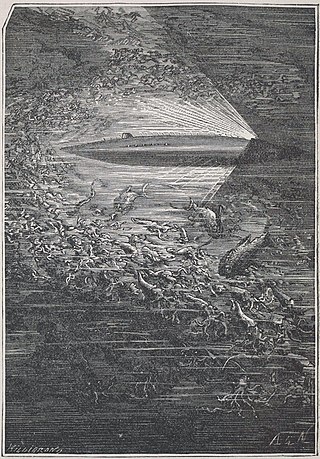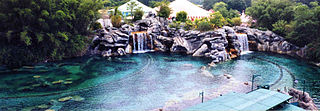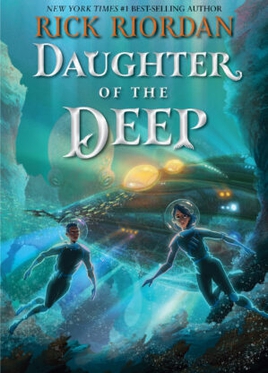
Twenty Thousand Leagues Under the Seas is a science fiction adventure novel by the French writer Jules Verne. It is often considered a classic within both its genres and world literature. The novel was originally serialised from March 1869 to June 1870 in Pierre-Jules Hetzel's French fortnightly periodical, the Magasin d'éducation et de récréation. A deluxe octavo edition, published by Hetzel in November 1871, included 111 illustrations by Alphonse de Neuville and Édouard Riou.

Nautilus is the fictional submarine belonging to Captain Nemo featured in Jules Verne's novels Twenty Thousand Leagues Under the Seas (1870) and The Mysterious Island (1875).

Captain Nemo is a character created by the French novelist Jules Verne (1828–1905). Nemo appears in two of Verne's science-fiction books, Twenty Thousand Leagues Under the Seas (1870) and The Mysterious Island (1875). He also makes a brief appearance in a play written by Verne with the collaboration of Adolphe d'Ennery, Journey Through the Impossible (1882).

The submarine film is a subgenre of war film in which most of the plot revolves around a submarine below the ocean's surface. Films of this subgenre typically focus on a small but determined crew of submariners battling against enemy submarines or submarine-hunter ships, or against other problems ranging from disputes amongst the crew, threats of mutiny, life-threatening mechanical breakdowns, or the daily difficulties of living on a submarine.
Karl Sigmund Stromberg is a fictional character and the main antagonist in the 1977 James Bond film The Spy Who Loved Me. Stromberg was portrayed by Curd Jürgens. The character Stromberg was created specifically for the film by writer Christopher Wood. Ian Fleming's novel The Spy Who Loved Me is told from the perspective of a young woman who falls in love with James Bond and its plot is completely different from the film. When Fleming sold the novel's rights to Eon Productions, he stipulated that only the title be used.

Captain Nemo is an Original English-language manga series written by Jason DeAngelis, with art by Aldin Viray and published by Seven Seas Entertainment. The first volume was released on March 1, 2006. Part of the manga is still online as a webmanga preview. Captain Nemo is meant to be a sequel to Jules Verne's 1870 novel Twenty Thousand Leagues Under the Seas.

The Submarine Voyage was an attraction at Disneyland in Anaheim, California. The attraction features vehicles designed to resemble submarines. It first opened on June 14, 1959, as one of the first rides to require an E ticket. It was part of a major expansion of Tomorrowland, which included the Matterhorn Bobsleds roller coaster, an expanded version of Autopia, the Disneyland Monorail, and the Motor Boat Cruise. The Submarine Voyage closed on September 8, 1998; at that time, it was reported that the attraction would reopen with a new theme by 2003, but that did not occur. The attraction ultimately reopened in June 2007 themed to Disney and Pixar's Finding Nemo, and now operates as Finding Nemo Submarine Voyage.

Les Mystères du Nautilus is a walkthrough attraction at Disneyland Paris in France. It is an updated version of the 20,000 Leagues Under the Sea walkthrough attraction that was at Disneyland in Anaheim, CA in the early 1950s, based upon the film of the same name. This attraction takes guests throughout the various rooms of Captain Nemo's submarine, especially those seen in the film. It opened on 4 July 1994.

20,000 Leagues Under the Sea: Submarine Voyage was an attraction at the Magic Kingdom theme park at Walt Disney World from 1971 through 1994. Based on the characters and settings of the 1954 Disney film 20,000 Leagues Under the Sea, which was adapted from Jules Verne's 1870 novel Twenty Thousand Leagues Under the Seas, it was a re-theming of the Submarine Voyage attraction at Disneyland. The ride involved a 20-minute submarine ride through a lagoon filled with sea life and mermaids.

20,000 Leagues Under the Sea is a 1954 American science fiction adventure film directed by Richard Fleischer, from a screenplay by Earl Felton. Adapted from Jules Verne's 1870 novel Twenty Thousand Leagues Under the Seas, the film was produced by Walt Disney Productions. It stars Kirk Douglas, James Mason, Paul Lukas, and Peter Lorre. Photographed in Technicolor, the film was one of the first feature-length motion pictures to be filmed in CinemaScope. It was also the first feature-length Disney film to be distributed by Buena Vista Distribution.

20,000 Leagues Under the Sea is a 1916 American silent film directed by Stuart Paton. The film's storyline is based on the 1870 novel Twenty Thousand Leagues Under the Seas by Jules Verne. It also incorporates elements from Verne's 1875 novel The Mysterious Island.

Captain Nemo and the Underwater City is a 1969 British film directed by James Hill and starring Robert Ryan, Chuck Connors and Nanette Newman. It features the character Captain Nemo and is inspired by Jules Verne's 1870 novel Twenty Thousand Leagues Under the Seas. It was written by Pip and Jane Baker.

20,000 Leagues Under the Sea is a 1997 two-part television miniseries produced by Village Roadshow Pictures Television, based on the 1870 novel Twenty Thousand Leagues Under the Seas by Jules Verne. It was written by Brian Nelson and directed by Rod Hardy.

20,000 Leagues Under the Sea is a 1997 television film directed by Michael Anderson and starring Ben Cross as Captain Nemo. It premiered on March 23, 1997. Based on the 1870 novel of the same name by Jules Verne, it is most notable for replacing the character of Professor Aronnax's manservant, Conseil, with the Professor's daughter, Sophie, who disguises herself as a boy so that she may accompany her father aboard USS Abraham Lincoln; she becomes the apex of a love triangle involving Captain Nemo and Ned the harpooner. The film was produced by Hallmark Entertainment.

The League of Extraordinary Gentlemen, Volume One is a comic book limited series written by Alan Moore and illustrated by Kevin O'Neill, published under the America's Best Comics imprint of DC Comics in the United States and under Vertigo in the United Kingdom. It is the first story in the larger League of Extraordinary Gentlemen series. The story takes place in 1898 in a fictional world where all of the characters and events from Victorian literature coexist. The characters and plot elements borrow from works of writers such as Jules Verne, Sir Arthur Conan Doyle, Bram Stoker, H. G. Wells and Robert Louis Stevenson.
The Undersea Adventures of Captain Nemo is a Canadian animated television series of five-minute cartoons produced in 1975 by Rainbow Animation in Toronto, Ontario. The series follows the underwater adventures of Captain Mark Nemo and his two young assistants, Christine and Robbie, in their nuclear-powered submarine, the Nautilus.

Captain Nemo is a 1975 Soviet three-part television miniseries directed by Vasily Levin loosely based on the novels Twenty Thousand Leagues Under the Seas (1870), its 1874 sequel The Mysterious Island, and The Steam House (1880) by Jules Verne.
Jules Verne's 1870 novel Twenty Thousand Leagues Under the Seas has been adapted and referenced in popular culture on numerous occasions.

Daughter of the Deep is a middle grade fantasy-adventure novel by Rick Riordan. It was published on October 26, 2021, by Disney-Hyperion, and entered The New York Times Best Seller list.
















